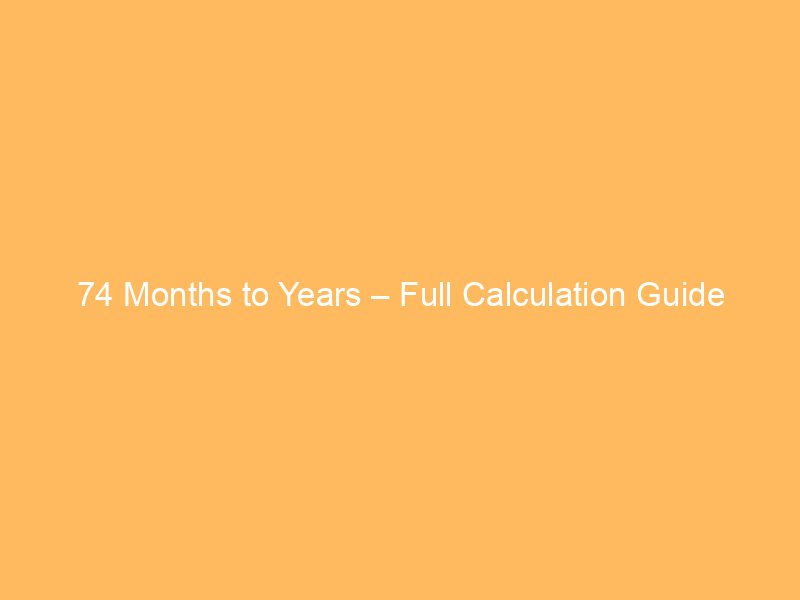74 months is equal to 6.1667 years.
To convert 74 months into years, you divide the total months by 12, because there are 12 months in one year. This gives the equivalent time duration expressed in years.
Conversion Tool
Result in years:
Conversion Formula
The formula to convert months to years is: years = months ÷ 12. Since there are 12 months in a year, dividing the number of months by 12 converts months into full years.
This work because the unit “year” is made up of 12 equal parts “months”. So when you have a total month number, splitting it by 12 gives the number of those parts, which is the years.
Example: Convert 74 months to years step-by-step:
- Start with total months: 74
- Divide by 12 (months per year): 74 ÷ 12 = 6.1666…
- Result is approximately 6.1667 years
Conversion Example
- Convert 36 months to years:
- Take 36 months
- Divide 36 by 12: 36 ÷ 12 = 3
- Answer: 3 years exactly
- Convert 50 months to years:
- Start with 50 months
- Divide 50 by 12: 50 ÷ 12 = 4.1667
- Result: about 4.1667 years
- Convert 95 months to years:
- Use 95 months
- 95 ÷ 12 = 7.9167
- So, 95 months equals roughly 7.9167 years
- Convert 27 months to years:
- Take 27 months
- 27 ÷ 12 = 2.25
- Answer: 2.25 years
- Convert 61 months to years:
- Start with 61 months
- Divide 61 by 12: 61 ÷ 12 = 5.0833
- So 61 months is about 5.0833 years
Conversion Chart
The chart below shows month values from 49.0 to 99.0 and their equivalent in years. You can find a month value, then look at the right side to see how many years it equals, making quick reference easier.
| Months | Years | Months | Years |
|---|---|---|---|
| 49.0 | 4.0833 | 74.0 | 6.1667 |
| 50.0 | 4.1667 | 75.0 | 6.25 |
| 51.0 | 4.25 | 76.0 | 6.3333 |
| 52.0 | 4.3333 | 77.0 | 6.4167 |
| 53.0 | 4.4167 | 78.0 | 6.5 |
| 54.0 | 4.5 | 79.0 | 6.5833 |
| 55.0 | 4.5833 | 80.0 | 6.6667 |
| 56.0 | 4.6667 | 81.0 | 6.75 |
| 57.0 | 4.75 | 82.0 | 6.8333 |
| 58.0 | 4.8333 | 83.0 | 6.9167 |
| 59.0 | 4.9167 | 84.0 | 7.0 |
| 60.0 | 5.0 | 85.0 | 7.0833 |
| 61.0 | 5.0833 | 86.0 | 7.1667 |
| 62.0 | 5.1667 | 87.0 | 7.25 |
| 63.0 | 5.25 | 88.0 | 7.3333 |
| 64.0 | 5.3333 | 89.0 | 7.4167 |
| 65.0 | 5.4167 | 90.0 | 7.5 |
| 66.0 | 5.5 | 91.0 | 7.5833 |
| 67.0 | 5.5833 | 92.0 | 7.6667 |
| 68.0 | 5.6667 | 93.0 | 7.75 |
| 69.0 | 5.75 | 94.0 | 7.8333 |
| 70.0 | 5.8333 | 95.0 | 7.9167 |
| 71.0 | 5.9167 | 96.0 | 8.0 |
| 72.0 | 6.0 | 97.0 | 8.0833 |
| 73.0 | 6.0833 | 98.0 | 8.1667 |
| 74.0 | 6.1667 | 99.0 | 8.25 |
Related Conversion Questions
- How many years are in 74 months exactly?
- What is the decimal year value for 74 months?
- How to convert 74 months to years with remainder months?
- Is 74 months closer to 6 or 7 years?
- What fraction of a year does 74 months represent?
- How many full years and extra months in 74 months?
- How does 74 months compare to 6.5 years?
Conversion Definitions
Months: A month is a unit of time based on the lunar cycle, approximately 29.5 days, but for calendar purposes, it is fixed as one of 12 divisions of a year. Each month can have 28, 29, 30, or 31 days depending on the calendar system used. Months organize the year into manageable parts.
Years: A year is the period Earth takes to complete one orbit around the Sun, approximately 365.25 days. It is divided into 12 months and is the standard unit for measuring longer durations of time, calendars, and age. Leap years adjust for the extra fraction of a day per year.
Conversion FAQs
Can I convert months to years without decimals?
Yes, but when converting months to years, the result will often be a decimal because months don’t perfectly divide into full years unless multiples of 12 are used. You can round the decimal or express it as years and leftover months for simplicity.
Why divide by 12 when converting months to years?
Because there are 12 months in a year. Dividing the number of months by 12 converts the total months into how many full years and parts of years they represent, since 12 months make a complete year cycle.
Is there a way to convert months to years and months separately?
Yes, you can divide the months by 12 to get the years, then use the remainder months as leftover. For example, 74 months ÷ 12 equals 6 years with 2 months remaining (since 6 × 12 = 72, and 74 – 72 = 2).
What if I want to convert months to fractional years with more precision?
Use the division with decimals and keep as many decimal places as you want. For example, 74 months ÷ 12 = 6.1666667 years. Increasing decimal places gives higher precision but may be unnecessary for casual use.
Does this conversion change if considering leap years?
No, the simple conversion of months to years by dividing by 12 assumes an average calendar year. Leap years add an extra day every four years, but months count remains the same, so the formula stays consistent for most purposes.





